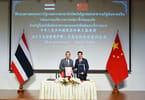The Tiger’s Nest is named after the mythical beast that carried the Guru Rinpoche, who brought Vajrayana Buddhism to Bhutan, to the mountaintop caves. The breathtaking views are splashed with color of the green Paro Valley, onto whose black rock the Tiger’s Nest is grafted; the ocher and orange of monks’ robes; the gold leaf of the statues of the Guru Rinpoche; and the endless lines of red, white, blue and yellow prayer flags strung from rocks and trees. Afterwards, your knees and ankles are in pain, but it’s nothing an herbal hot-stone bath at the Amankora can’t cure. Taking a pony is an easier option.
Many Bhutanese make this trip before they can walk, usually on their parents’ backs. They believe that the first question asked of them in the afterlife is, “Have you visited the Tiger’s Nest?”
A second thing to ease your path in the hereafter: in Bumthang, cleanse your sins by walking three times around the inner sanctum of the Tamshing Lhakhang temple while wearing the 50-lb., chain-link jacket of a 16th century saint!
Bhutan’s Kings are regular visitors at the temple complex. Built in the 17th century, it defies both gravity and civil engineering as it juts out from the sheer rock face. The country’s pre-eminent tourist destination was once the exclusive preserve of holy men, who have been traveling here since the 8th century to meditate in the mountains. The cave walls still bear faint remnants of early paintings of figures and scenes from Buddhist texts.
As you ascend the mountain, the structure seems at first to be carved from the rock face itself. Two lookout points offer better views, and it becomes clear that the people of the valley had to haul the building materials up the steep incline to build the magnificent thing.
How did pre-helicopter Bhutanese do it? An old man who has been meditating at the monastery for 40 years answered. “They had special powers,” he said. He shakes his head when you ask his name. He stoops forward, as if his posture has adapted to constant climbing, and his gray eyes hint at wisdom acquired from long contemplation.
Another question: How do today’s Bhutanese, with no special powers, manage to install long strings of prayer flags between mountains, across impossible chasms? He mimes the action of an archer pulling back an arrow on his bow. Of course. A traditional technique for a timeless need. In Shangri-la, there’s no more-authentic solution.
WHAT TO TAKE AWAY FROM THIS ARTICLE:
- Two lookout points offer better views, and it becomes clear that the people of the valley had to haul the building materials up the steep incline to build the magnificent thing.
- The country's pre-eminent tourist destination was once the exclusive preserve of holy men, who have been traveling here since the 8th century to meditate in the mountains.
- As you ascend the mountain, the structure seems at first to be carved from the rock face itself.






















